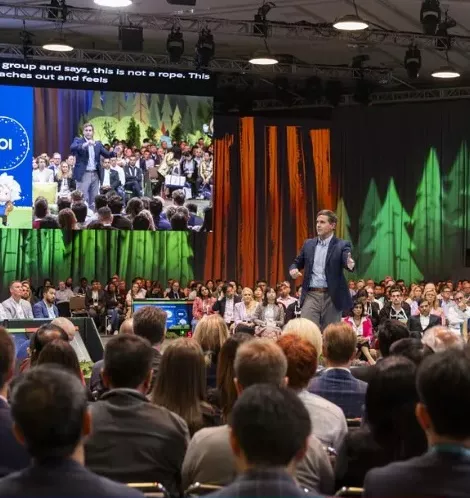Navigating the new renaissance: Leadership in the age of AI

How to inspire your teams in a time of unprecedented change and opportunity
As we journey into the age of artificial intelligence (AI), we face a pivotal moment reminiscent of the emergence of photography in the 19th century. With the invention of photography, artists initially feared their craft would become obsolete. However, rather than succumbing to despair, they pivoted, leading to the birth of the modern art movement. This shift in perspective transformed the realm of art in ways previously unimaginable.
Today, as AI and automation permeate our workspaces, we’re confronted with a similar predicament. On the one hand, we could succumb to the “race to the bottom“ mentality, using AI to cut costs and lay off employees. On the other hand, we could seize the opportunity to inspire, motivate, and reinvent our workplaces. This could lead to a renaissance in human creativity and productivity that we can’t yet fully comprehend.
Leadership in the AI era
Leadership in the age of AI requires reframing our traditional understanding of the role. Instead of being the sole decision maker or problem solver, leaders are now tasked with guiding and inspiring their teams toward self-directed problem-solving and innovation.
Today, leaders are given the opportunity to cultivate an environment that fosters creativity, collaboration, and continuous learning. They can facilitate their teams’ adaptation to technological advancements and enable them to leverage these tools for maximum impact.
Moreover, the rise of AI does not signify the end of human work, but rather a shift in the nature of our work. The advent of AI and automation can free up our time from routine and mundane tasks, allowing us to focus on work that requires critical thinking, creativity, and emotional intelligence—aspects that AI cannot replicate.
Harnessing the power of AI to inspire and motivate
How can leaders inspire and motivate their teams in this new era? The answer lies in leveraging the possibilities that AI and automation present.
First, leaders can utilize the “extra time“ afforded by AI to deepen relationships within their teams. They can spend more time understanding their team members’ aspirations, strengths, and areas for improvement. This can help foster a culture of trust, mutual respect, and open communication.
Second, leaders can empower their teams to harness the power of AI by providing the necessary resources for them to learn and adapt to new technologies. This entails promoting a mentality centered around perpetual learning and adjustment. By embracing a mindset of continuous growth, individuals can navigate challenges with resilience and seize opportunities for personal and professional development.
Lastly, leaders can inspire their teams to view AI not as a threat but as an enabler of innovation. They can challenge their teams to think creatively about how to leverage AI to improve their workflows and processes, or even create new products or services.
- Embrace ambiguity and uncertainty: The AI era is marked by rapid advancements and uncertainty. Leaders must navigate ambiguity, by making confident and thoughtful decisions despite incomplete information. Embracing uncertainty as an opportunity for growth enables leaders to adapt and thrive in an ever-evolving landscape.
- Champion ethical and responsible AI: As AI increasingly permeates our lives, leaders are responsible for ensuring its ethical and responsible use. By championing transparency, fairness, and accountability in AI systems, leaders can build trust within their organizations and with external stakeholders.
- Empower employee upskilling: Resilient leaders understand that AI is not a replacement for human capabilities but a tool for augmentation. They invest in employee upskilling programs to equip their teams with the skills necessary to work with AI technologies. Empowered employees become adaptable and resilient contributors in the AI-driven workplace.
- Lead with authenticity and empathy: Resilient leaders lead by example with both authenticity and empathy. They create a supportive environment where team members feel valued and understood. Leaders foster resilience and promote a sense of belonging by showing genuine care for their team’s well-being.
Enabling an unimaginable transformation
The true potential of AI lies not in its ability to replace human labor but in its potential to unlock human creativity and innovation. As leaders, we must harness this potential to enable an extraordinary transformation in our workplaces.
By empowering our teams to leverage AI, we can redefine the meaning of work, moving away from mundane tasks and toward what truly inspires and engages us. This shift can lead to higher levels of job satisfaction, increased productivity, and a culture that fosters ongoing learning and encourages continuous innovation.
Moreover, by fostering a culture of trust and mutual respect, leaders can create an environment where employees feel valued and empowered. This can lead to higher levels of employee engagement and retention and improved team performance.
The human-future paradigm involves leading through change and discovery
The rapid pace of technological advancement necessitates a reimagining of leadership paradigms. The future is no longer about merely adapting to change but about shaping that change and transforming it into opportunities for growth, innovation, and human development. To rise to this challenge, leaders must adopt a visionary, human-centric approach, driving both technological prowess and human potential to create a sustainable future. This includes:
- Visionary leadership: Leaders need to be forward-thinking, anticipating the implications of technological changes and imagining a future where technology and human creativity coexist harmoniously.
- Inclusive decision-making and empowerment: Leaders should foster an environment where diverse perspectives are valued and where team members feel empowered to make decisions, take risks, and innovate.
- Continuous learning and adaptation: Leaders must nurture a continuous learning and adaptation culture, providing resources for individuals to cultivate new skills and abilities.
- Resilience and flexibility: It’s essential to instill resilience and flexibility within teams, encouraging them to view challenges as opportunities for growth and innovation.
- A human-centric approach: The increasing role of technology underscores the importance of people-centric leadership, requiring leaders to cultivate emotional intelligence, empathy, and compassion.
- Ethical leadership and collaboration: Leaders must maintain strong ethical standards and foster a culture of collaboration, both within their teams and through partnerships outside their organizations.
Leadership in the era of rapid technological change is not a title but a mindset, a responsibility. It’s about envisioning and shaping a future that we can all be proud of—one where technology magnifies human potential instead of replacing it.
Leaders have a pivotal role as architects of this new era, creating an environment that motivates and empowers. Just as the invention of photography transformed the art world, today’s technological advancements offer us a chance to redefine work and human creativity. Let’s embrace this exciting journey together, anticipating new discoveries and creations, rather than fearing what we might lose. The rise of AI presents leaders with a unique opportunity to inspire and unleash the full potential of their teams.
This blog post was originally published here.




